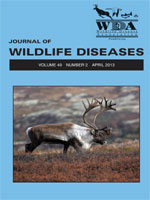Knowledge of parasites shed by wild canids can assist in recognizing risk to human and domestic animal health. Our aim was to estimate the prevalence of patent infections with Toxocara canis and other parasites in foxes (Vulpes vulpes) and coyotes (Canis latrans) in Prince Edward Island, Canada. Identification of parasite species was based on microscopic examination of feces, with the use of a sucrose fecal flotation method. Sample collection was performed in winter on carcasses of 271 and 185 hunted or trapped foxes and coyotes, respectively. One or more parasite species were observed in 242 (89%) foxes and 128 (69%) coyotes. Toxocara canis, Uncinaria stenocephala, Capillaria spp., Mesocestoides, Taenidd spp., Alaria spp., Cryptocotyle lingua, Sarcocystis spp., Neospora caninum–like coccidia, and other coccidia were identified. A third of juvenile foxes were shedding T. canis and had a high prevalence of Capillaria spp., especially in juvenile foxes (69%). Taenidd eggs, Alaria spp. and Sarcocystis spp. were more common in coyotes (24, 18, and 9%, respectively) than foxes (8, 11, and 1%, respectively). Despite the limitations of fecal flotation to identify parasite species, the high prevalence of T. canis warrants the attention of public health professionals.
How to translate text using browser tools
1 April 2013
Fecal Shedding of Toxocara canis and Other Parasites in Foxes and Coyotes on Prince Edward Island, Canada
Wendela Wapenaar,
Herman W. Barkema,
Ryan O’Handley
ACCESS THE FULL ARTICLE

Journal of Wildlife Diseases
Vol. 49 • No. 2
April 2013
Vol. 49 • No. 2
April 2013
Canada
coyote
fox
protozoa
Taenia
Toxocara canis
zoonosis




